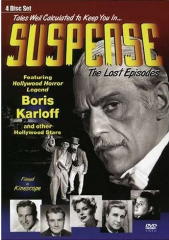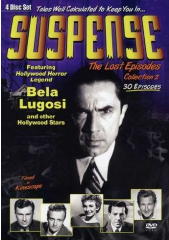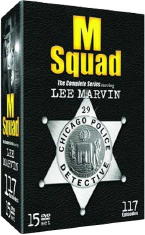Sun 5 Jul 2009
MIKE NEVINS on Suspense (the TV show), NYPD, and M Squad.
Posted by Steve under Columns , TV mysteries[7] Comments
by Francis M. Nevins
I was nine years old in 1952 when my parents bought their first TV set. Being a little young at the time, I never watched what was perhaps the leading crime-drama anthology series of the early Fifties, CBS-TV’s Suspense, which had been heard on radio for almost a dozen years and debuted on the small screen early in 1949.

Just recently, however, I’ve begun to catch up, thanks to the release of three DVD sets containing several dozen episodes, including some of the earliest.
One of these, “Help Wanted” (June 14, 1949), was based on “The Cat’s-Paw,” the second published short story of the soon to be legendary Stanley Ellin (1916-1986),which had just appeared in the June 1949 issue of Ellery Queen’s Mystery Magazine.
A few evenings ago I ran this episode and then re-read the story. Both deal with a middle-aged unemployed loner named Crabtree to whom an anonymous party offers $50 a week (a generous salary in those days) to sit in a tiny office on the top floor of a skyscraper, eight hours a day six days a week, and compile useless financial reports.
Later Crabtree’s benefactor pays him a visit and offers him life tenure, as it were, if he’ll push his next visitor out the office window. Here is where Ellin and the writers of the TV version (Mary Orr and Reginald Denham) part company. In the story Crabtree follows through, although offstage (because Ellin almost never shows an act of violence), and gets away with it because his employer has made the death look like suicide.
On the air, whose censors looked askance at unpunished crimes, the visitor falls out of the window accidentally because of his paranoid fear of the office cat, and the intended murder is impliedly brought home to Crabtree’s Iago because the victim was the wrong man, not a blackmailer but a harmless crackpot soliciting money for a campaign to bring back Prohibition.
Otto Kruger played Crabtree, and Douglas Clark-Smith, who gives the impression of having been drunk on camera, was “Mr. X”.
This live drama, directed by Robert Stevens, was the first of at least fifteen live or filmed TV adaptations of Ellin stories. The same tale, translated to film with the same title and a script based on this one, later became the basis of an episode of Alfred Hitchcock Presents (April 1, 1956), with John Qualen and Lorne Greene in the roles of Crabtree and his employer and James Neilson directing.

Also on Disc One of Collection One from Suspense is “The Murderer” (October 25, 1949), based on Joel Townsley Rogers’ often anthologized short story of the same name (Saturday Evening Post, November 23, 1946).
The story begins just after dawn on a lonely meadow, probably in the same general area where so much of Rogers’ powerful suspense novel The Red Right Hand (1945) was set. Farmer John Bantreagh discovers the dead body of his sluttish wife, knocked unconscious and then deliberately run over by a car.
Then deputy Roy Clade drives up, and the dialogue between the men heightens our suspicion that Bantreagh himself is the murderer. These two are the only onstage characters in Rogers’ story.
In the Suspense version, directed by Robert Stevens from a Joseph Hayes teleplay, Jeffrey Lynn and John McQuade played Bantreagh and Clade but there are also several other characters who in Rogers’ story were only referred to in the dialogue.
This tale was never adapted for Alfred Hitchcock Presents but did become the basis of a later live version on ABC’s Star Tonight (March 17, 1955), with Bantreagh and Clade played by Charles Aidman and Buster Crabbe.
During my three years at NYU Law School I watched very little TV, but in the fall of 1967, when I was still living in Greenwich Village and waiting for the results of the bar exam (yes, I passed), a new series debuted on ABC which, with its tension and its reflection of the turbulence of the Vietnam and Black Power years and its abundant action scenes shot on the streets of New York, captivated me instantly.

N.Y.P.D., starring Jack Warden as tough detective lieutenant Mike Haines, Robert Hooks as black plainclothesman Jeff Ward and Frank Converse as newbie Johnny Corso, was directed and scripted for the most part by veterans of the golden age of live teledrama and lasted two full seasons.
Looking over the cast lists recently, I was amazed at the number of actors then based in New York who appeared in one or more episodes and went on to household-name recognition and in some cases superstardom.
In alphabetical order and limiting myself to males: John Cazale, James Coco, William Devane, Charles Durning, Robert Forster, Vincent Gardenia, Charles Grodin, Moses Gunn, James Earl Jones, Harvey Keitel, Tony LoBianco, Laurence Luckinbill, Al Pacino, Andy Robinson, Mitchell Ryan, Roy Scheider, Martin Sheen, Jon Voight, Sam Waterston, Fritz Weaver.
Fewer female cast members made it big, but among those that did were Jill Clayburgh, Blythe Danner and Nancy Marchand.

None of these names were familiar to me 40-odd years ago except James Earl Jones, whom I’d seen in an off-off-Broadway production of Othello, but today they’re instantly recognizable by millions. Why this superb series hasn’t been revived on DVD is a mystery; the fact that it hasn’t is a shame.
Speaking of vintage TV cop shows, M Squad, starring Lee Marvin, is now available on DVD, the complete 115-episode series for around $120. That’s pretty steep even if you buy the set with a 40% Borders Rewards discount coupon, but many who were teens during its first run as I was will be sorely tempted.
July 5th, 2009 at 6:30 pm
I would love to get the “M Squad.” But besides the price, who has time to view the 115 episodes? It seems the distributors are releasing more and more of these older TV shows in complete series sets. I’m not sure I like it that way.
July 5th, 2009 at 7:28 pm
The current Amazon price is $69.99, and that includes shipping. For three seasons of shows, it’s a steal, and I’d say that everyone reading this really ought to have a set.
You might be right that they should have done it as three separate seasons. I’d hate to have other companies to look at poor sales on the M SQUAD set and use that as an excuse to not put out sets of shows they own the rights to.
Shows such as N.Y.P.D., which Mike also talks about in this column. It’s available in the collector-to-collector market, but it would be nice to have an authorized edition.
And don’t knock the importance of the collector-to-collector market. Some of the episodes in the M SQUAD box set came to light only because of collectors.
July 5th, 2009 at 10:20 pm
Concerning M SQUAD and the time needed to watch over 100 episodes, I’ve discovered the best way to view old TV shows is to set aside a half hour or hour after dinner each day and watch shows on a rotating basis. I have quite a few sets of TV shows and have managed to watch hundreds of episodes.
To see Lee Marvin as Lt. Ballard is really quite a treat because it shows how hardboiled and tough Marvin could be. There is no silly love interest or any other distractions, just Lt Ballard solving crimes and arresting crooks, all in 30 minutes.
July 6th, 2009 at 5:21 am
I suspect Walker is right that the best way to watch these is to set aside a little time and watch them on a rotating basis — not unlike the way they originally aired.
I’m not sure a marathon is a good way to watch any television series unless you are trying to see how many episodes of Star Trek or The Twilght Zone you can watch before your head explodes, or catching up on missed episodes of a self contained or limited series. I watch old movie serials much the same way, one or two episodes a day, rather than trying to cram 12 or 15 into one sitting. Whatever their charms there are only so many times a day you can jump off that same cliff into that same lake before you reach your limit.
I strung out the British series the Protectors nearly three months and still have one serial of Sapphire and Steel to watch. I’m pretty sure I would have gotten sick of both if I tried to watch the whole thing. I do the same with movie series, maybe watch a Falcon or Saint one day, Charlie Chan or Mr. Moto the next, the Whistler, Nancy Drew, Boston Blackie, another. Just whatever you are in the mood for right then. Other wise it becomes too much like work. Unless I’m writing about one of them I try to watch them just for fun.
The list of largely New York based actors in N.Y.P.D. reminded me how much fun it can be to watch some of the New York based series and films of the late fifties and early sixties. Cop Hater, based on the 87the Precinct novel was on TCM last year, with a young Robert Loggia as Steve Carelli (sic) and in the incidental cast Vincent Gardenia as a drug addicted informer and Jerry Orbach as a juvenile delinquent. And at least one of those compilations of old tv series has an episode of the Ralph Bellamy Man Against Crime series set at the six day bike races in New York with a stunningly young Martin Balsam.
We forget how much television some big stars did, two episodes of the Hitchcock Hour with Robert Redford as well as Twilight Zone, Wagon Train, Naked City, and Perry Mason. There’s even some kinescopes of many of Paul Newman’s early appearances, though you have to travel to New York to screen the musical adaptation of Our Town with Newman and Eva Marie Saint and Frank Sinatra as the Stage Manager.
I’m sure I’m not alone in wanting to see some of the live television adaptations that were done for various programs such as Whit Bissel in John Dickson Carr’s The Devil in Velvet and George C. Scott and Dana Wynter in The Burning Court; Eli Wallach in Simenon’s Stan the Killer; Dick Powell as Philip Marlowe in The Long Goodbye; or the lost pilot for Michael Shayne with Mark Stevens. Alas, we will probably just get the umpteenth redoing of Marty, Requiem for a Heavyweight, and Patterns. They do like to revisit televisions cultural side.
Re M Squad, even at the time it was an exceptionally stripped down, lean, and mean series. If I remember right it came in for some criticism for the level of violence and for Marvin’s ruthless Lt. Ballard. All the more reason to watch it today.
July 6th, 2009 at 12:44 pm
We Chicagoans always took a kind of perverse pride in M Squad, because it was well known that Mayor Daley I and his machine disapproved of it, and would not permit location filming. In a TV Guide interview, Lee Marvin bragged about how he would go to Chicago with a second unit and steal shots of various local landmarks, which would be sprinkled into the Hollywood-made episodes. Those were the days…
By the way, Marvin’s character was Lt. Frank Ballinger, not Ballard. Easy to remember – it sort of rhymes with another local figure of note.
December 28th, 2020 at 12:06 am
Well I just learned something new. Suspense! on radio tonight starred Howard Da Silva in an episode called, ‘You Take Ballistics’. The clue to the crime was that a crook can “fake” which type of bullet can be shot from which type of pistol barrel. A .32 vs .38 makes no difference –what you do is wrap the smaller caliber shell in a few cigarette papers and fit it into the larger caliber barrel. It will still fire. Wheee!
December 28th, 2020 at 12:17 am
Stanley Ellin (I see him named in the above review) naturally everyone here knows him more familiarly than myself. But the qualities which make him legendary were immediately apparent to me on just one novel from him. ‘The Eighth Circle’. Extraordinary. I often recommend it to friends.
Also: the juicy info on this early, early, early police TV-series (N.Y.P.D.). Holy hannah. All those stars appeared on this program, in their earliest days? Egad. That’s something I’d go out of my way to view. What a feast of talent.